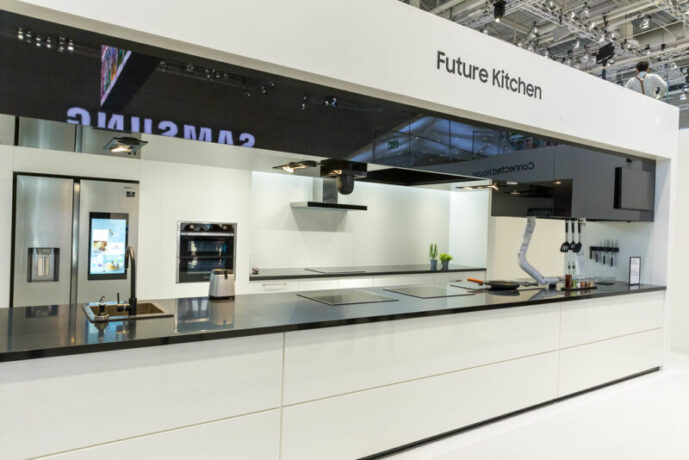What is smart kitchen
A smart kitchen refers to a kitchen equipped with advanced technologies and connected devices that enhance functionality, convenience, and efficiency in cooking and food preparation. Smart kitchen technology incorporates automation, connectivity, and intelligent features to transform the kitchen into a more streamlined and intuitive space. Here are some key components and features of a smart kitchen:
- Connected Appliances: Smart kitchen appliances, such as refrigerators, ovens, dishwashers, and coffee makers, are equipped with connectivity features. They can be controlled remotely through smartphone apps or voice commands, allowing users to monitor and adjust settings from anywhere.
- Voice Assistants: Integration with voice assistants like Amazon Alexa or Google Assistant enables hands-free control of kitchen devices. Users can give voice commands to perform tasks like setting timers, adjusting temperatures, or adding items to shopping lists.
- Smart Lighting: Lighting systems with smart features can be integrated into the kitchen. These lights can be controlled remotely or automated to adjust brightness or color based on the desired ambiance or specific tasks, such as cooking or dining.
- Connected Cookware and Utensils: Smart kitchen gadgets like smart scales, thermometers, and cooking utensils can be connected to smartphones or tablets. They provide real-time data, recipe suggestions, and guidance to achieve precise cooking results.
- Automated Appliances and Routines: Smart kitchen appliances can be programmed to perform specific tasks automatically. For example, an oven can preheat at a scheduled time, a coffee maker can start brewing when you wake up, or a dishwasher can run during off-peak energy hours.
- Recipe and Meal Planning Apps: Smart kitchen technology includes recipe apps and platforms that provide access to a vast library of recipes, personalized recommendations, and meal planning features. These apps can offer step-by-step instructions, ingredient suggestions, and even help with grocery shopping.
- Food Management: Smart refrigerators equipped with cameras and sensors can track and manage food inventory. They can send expiration date alerts, suggest recipes based on available ingredients, and even generate shopping lists based on what needs to be restocked.
- Energy Efficiency: Smart kitchen technology often focuses on energy efficiency. Appliances can optimize energy usage, and smart power strips or plugs can be used to control and monitor power consumption of multiple devices.
Smart kitchens offer convenience, time-saving features, and improved control over various aspects of cooking and food management. They can enhance efficiency, reduce waste, and simplify meal planning and preparation, making the kitchen a more enjoyable and connected space.
Are smart kitchen appliances worth it
Determining whether smart kitchen appliances are worth it depends on your personal needs, preferences, and budget. Here are some factors to consider when evaluating the value of smart kitchen appliances:
- Convenience and Efficiency: Smart kitchen appliances offer convenience and efficiency through features like remote control, voice commands, and automation. For example, you can preheat your oven while still at the grocery store or start brewing coffee from bed using a smartphone app. These time-saving features can be valuable for busy individuals or those who prioritize convenience in their daily routines.
- Energy Efficiency: Many smart appliances come with energy-saving features, such as optimizing power usage or providing real-time energy consumption data. These features can help you monitor and reduce energy usage, potentially leading to cost savings on utility bills over time.
- Integration and Connectivity: Smart appliances often integrate with other devices and platforms, allowing for seamless connectivity and automation. For instance, you can sync your smart refrigerator with a meal planning app or connect your smart oven to voice assistants for hands-free control. If you enjoy a connected and integrated home environment, smart appliances can enhance the overall experience.
- Enhanced Features and Functionality: Smart appliances often come with additional features not found in traditional counterparts. These features can include touchscreens, recipe suggestions, food inventory tracking, or compatibility with voice assistants. Assess whether these added functionalities align with your needs and preferences.
- Long-Term Cost Considerations: While smart kitchen appliances may have a higher upfront cost compared to traditional options, it’s important to consider long-term savings and benefits. Energy-efficient features can help reduce utility bills, and automation and convenience may improve your overall cooking experience.
- Personal Preference and Tech Enthusiasm: If you have a strong interest in technology and enjoy the latest advancements, investing in smart kitchen appliances can align with your personal preferences. The excitement of having a connected kitchen and exploring new features can be a valuable aspect for tech enthusiasts.
However, it’s worth noting that not all smart appliances may offer significant advantages over their traditional counterparts. Some features might be considered gimmicky or unnecessary for certain individuals, and the higher cost can be a deterrent for budget-conscious consumers.
Ultimately, whether smart kitchen appliances are worth it is subjective and depends on your specific needs, priorities, and financial considerations. Research different models, read user reviews, and evaluate the features and benefits in relation to your lifestyle to make an informed decision.
Step-by-Step Guide: Transforming Your Kitchen into a Smart Haven
In today’s digital age, smart technology has revolutionized our homes, making them more efficient, convenient, and connected. One area where smart technology can truly shine is in the kitchen. Imagine a kitchen where appliances can be controlled with a voice command, where recipes are readily available at your fingertips, and where food inventory is effortlessly managed. With a few simple steps, you can transform your kitchen into a smart haven. In this article, we will guide you through the process of creating your very own smart kitchen.
Step 1: Assess Your Needs and Prioritize:
Start by assessing your needs and determining which aspects of your kitchen would benefit from smart technology. Consider factors like convenience, energy efficiency, and functionality. Identify areas that you would like to automate or improve upon, such as appliances, lighting, or meal planning.
Step 2: Research and Choose Smart Appliances:
Research different smart appliances available in the market and select ones that align with your needs and budget. Look for appliances with connectivity features, voice control compatibility, and energy-efficient options. Smart refrigerators, ovens, coffee makers, and dishwashers are popular choices to consider.
Step 3: Upgrade Your Lighting System:
Upgrade your kitchen lighting system to a smart lighting solution. Install smart light bulbs or switches that can be controlled remotely or integrated with voice assistants. Explore features like adjustable brightness, color temperature, and scheduling to create the perfect ambiance for various tasks.
Step 4: Integrate Voice Assistants:
Integrate voice assistants like Amazon Alexa or Google Assistant into your kitchen. Set up compatible smart speakers or displays that allow you to control appliances, play music, set timers, and even access recipes with simple voice commands.
Step 5: Implement Smart Food Management:
Simplify food management with smart solutions. Consider a smart refrigerator with built-in cameras and inventory management features. This allows you to monitor and track food items, receive expiration date alerts, and generate shopping lists based on what needs to be restocked.
Step 6: Explore Recipe and Meal Planning Apps:
Discover recipe and meal planning apps that can enhance your cooking experience. These apps offer a vast database of recipes, personalized recommendations, and the ability to create shopping lists based on chosen recipes. Some apps even provide step-by-step instructions and help with substitutions.
Step 7: Connect and Automate:
Connect your smart appliances, lighting, and voice assistants to a central hub or home automation system. This integration allows for seamless control and automation of various functions within your kitchen. Set up routines and schedules to automate tasks like preheating the oven or brewing coffee.
Step 8: Prioritize Security and Privacy:
As with any smart technology, prioritize security and privacy. Ensure that you choose reputable brands with a focus on security features. Regularly update firmware and passwords, and consider network segmentation to protect your smart devices and data.
Conclusion:
Transforming your kitchen into a smart haven is an exciting journey that brings convenience, efficiency, and modernity to your cooking experience. By following these step-by-step guidelines, you can create a connected kitchen that simplifies tasks, saves time, and enhances your overall enjoyment of cooking. Embrace the wonders of smart technology and embrace a future where your kitchen becomes the heart of your smart home.

